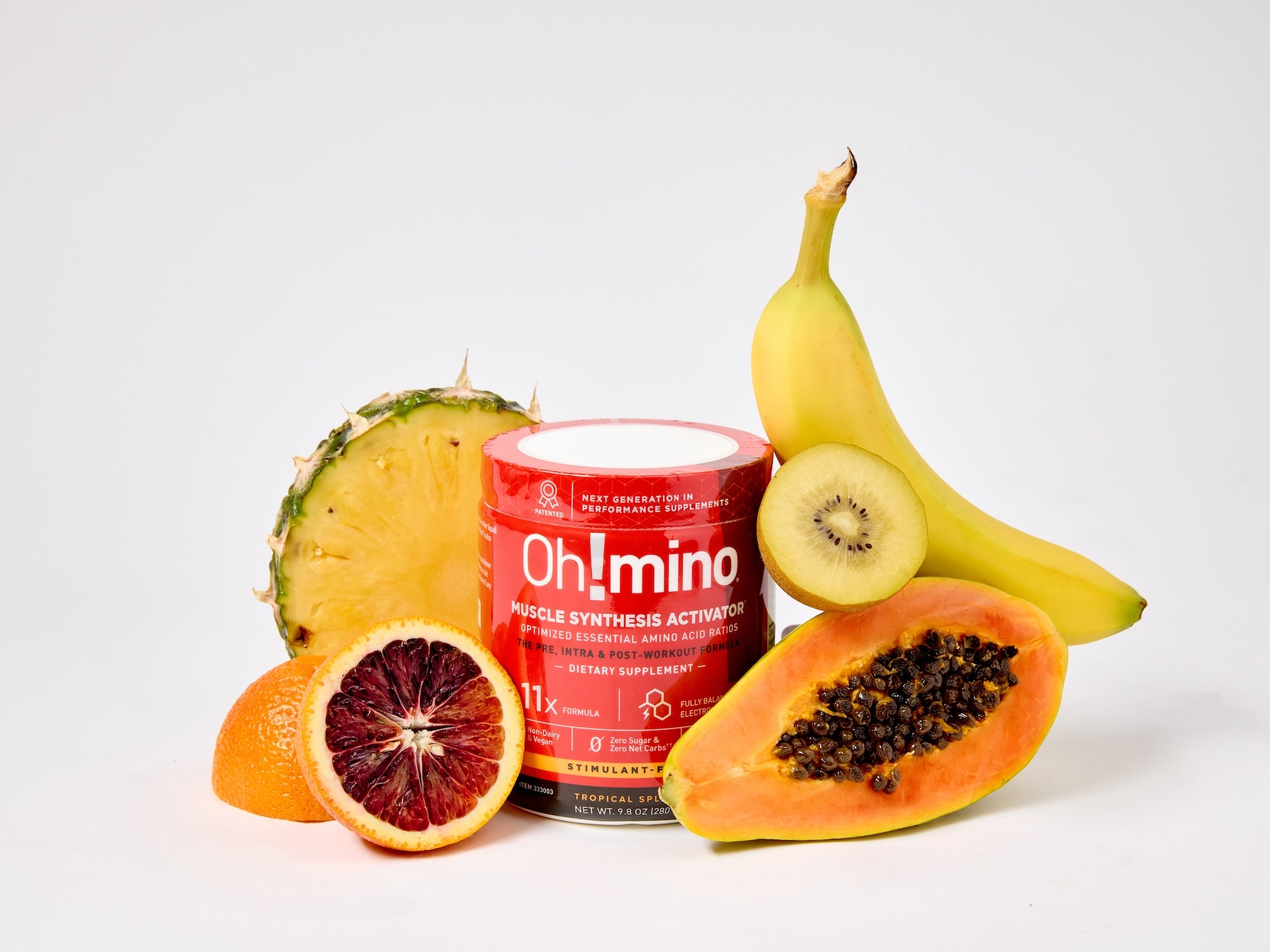Key Takeaways
-
Training to failure creates significant physiological stress that can lead to joint problems, prolonged exhaustion, and decreased performance when used excessively.
-
Submaximal training (1–3 reps short of failure) produces similar muscle growth with better recovery and reduced injury risk, making it the preferred approach for most training sessions and trainees.
-
Optimal recovery support becomes critical during intense training phases. Complete amino acid nutrition like Oh!mino® Muscle Synthesis Activator provides the building blocks for muscle repair and protein synthesis, helping you recover faster from failure training sessions.
The Fine Line Between Maximum Gains and Overtraining
If you've ever watched a documentary about Arnold Schwarzenegger, you know how hardcore he was. And he wasn't an outlier. All the old-school bodybuilders were doing the same—training to failure each and every set.
But is that really necessary? Do you have to train to failure each time if you want to achieve maximum muscle growth, or is that approach counterproductive?
The question of training to failure has divided the fitness community for decades. On one side, you have the hardcore advocates who believe that only by pushing your muscles to their absolute limit can you trigger maximum growth. On the other side, you have those who argue that strategic submaximal training produces better long-term results with less risk of injury and burnout.
The truth, as often happens in exercise science, lies somewhere in the middle. Understanding when, how, and why to train to failure can be the difference between making steady progress and hitting frustrating plateaus or even regressing due to overtraining.
|
Oh!mino©: Elevate Your Performance. Accelerate Your Recovery. Science-Backed Superiority for Every Fitness Journey Power Your Goals with Proven Results:
The Oh!mino® Advantage: ✓ Patented formula that’s 11x more effective than protein, 20x more effective than BCAAs Choose Your Perfect Formula: Available in refreshing Tropical Slash or Berry Blast flavors, with stimulant-free or caffeinated options. Prefer capsules? We've got you covered with the same powerful formula. Take before, during, or after training—one solution for your entire workout. |
Understanding Training Intensity and Muscular Failure
To better understand what it means to train to failure, let's first talk about training intensity. Intensity is a measure of how close you come to your maximum strength capabilities. In other words, it’s how close you are to your one-rep maximum.
For example, if your one-rep max on the bench is 300 lbs, and you're lifting 240 lbs, that means you're lifting at 80% intensity. This percentage-based approach to training intensity helps us understand the physiological demands we're placing on our bodies and nervous systems.
Training to failure occurs when you can no longer complete another repetition with proper form despite maximum effort. This represents 100% of your capacity for that particular set and rep range. At this point, your muscles have exhausted their ability to generate sufficient force to overcome the resistance, and various physiological systems have reached their limits.
The Physiological Cost of Constant Failure Training

If you're constantly training to your maximum capacity, you might face some muscular issues.
Joint and Ligament Stress
Training to failure consistently places enormous stress on your connective tissues, including joints, ligaments, and tendons. When muscles fatigue completely, form typically breaks down, leading to compensatory movement patterns that can overload specific joints.
The repetitive stress of maximum effort training can lead to chronic inflammation in joint capsules and surrounding tissues. Over time, this can result in persistent aches, reduced range of motion, and increased susceptibility to acute injuries. The connective tissues adapt more slowly than muscle tissue, making them particularly vulnerable when training loads exceed their recovery capacity.
Prolonged Muscle Exhaustion and Systemic Fatigue
Constant failure training leads to deep muscle fatigue that extends well beyond the typical 24–48 hour recovery window. This occurs because training to failure depletes multiple energy systems simultaneously while creating extensive muscle damage that requires significant resources to repair.
Additionally, the hormonal response to constant high-intensity training can shift toward a more catabolic state, with elevated cortisol levels and reduced anabolic hormone production. This hormonal imbalance can perpetuate the cycle of fatigue and poor recovery, making each subsequent workout less productive than the previous one.
Lower Strength and Performance Decline
Paradoxically, training to failure too frequently can actually reduce your strength capabilities over time. This occurs through several mechanisms, including accumulated fatigue, neural exhaustion, and incomplete recovery between sessions.
When the nervous system becomes overloaded from constant maximum effort training, it can reduce its output as a protective mechanism. This manifests as an inability to recruit muscle fibers as efficiently, leading to decreased force production even when muscles are physically capable of generating more power.
Strategic Implementation of Failure Training

There are various failure training strategies that allow you to maintain higher training frequencies and volumes while still providing sufficient stimulus for muscle growth and strength development.
Linear Periodization Approach
One effective strategy is to periodize your use of failure training throughout different phases of your program. During base building phases, focus on submaximal training to develop work capacity and movement proficiency. As you progress toward peak phases, gradually introduce more failure sets to maximize the training stimulus.
This approach allows you to build a solid foundation of fitness while progressively increasing the intensity to drive adaptations. The key is timing the introduction of failure training when your body is best prepared to handle and recover from the additional stress.
Block Periodization Method
Another approach involves dedicating specific training blocks to failure training followed by periods of active recovery or submaximal training. This allows you to maximize the benefits of high-intensity training while ensuring adequate recovery to prevent overreaching.
During failure training blocks, you might train to failure on 2–3 sets per muscle group per week for 3–4 weeks, followed by a deload week or a return to submaximal training. This cyclical approach can prevent the negative adaptations associated with chronic high-intensity training.
Autoregulatory Training Methods
Advanced trainees might benefit from autoregulatory approaches that adjust failure training based on daily readiness and performance indicators.
This might involve using RPE (Rate of Perceived Exertion) scales, velocity-based training metrics, or subjective wellness questionnaires to determine when to push to failure versus when to back off.
Recovery Protocols for High-Intensity Training
Sleep Optimization for Maximum Recovery

Quality sleep becomes non-negotiable when training to failure regularly.
During deep sleep phases, your body produces the majority of its growth hormone, which is essential for muscle repair and adaptation. Aim for 7–9 hours of quality sleep nightly, with consistent bedtimes and wake times to optimize your circadian rhythms.
Nutritional Strategies for Intense Training
Failure training places extraordinary demands on your body's energy systems and recovery mechanisms. Adequate protein intake becomes crucial, with recommendations ranging from 1.2–2.0 grams per kilogram of bodyweight depending on training intensity and goals.
Active Recovery and Stress Management
Incorporating active recovery sessions between intense failure training days can enhance circulation, promote metabolic waste removal, and maintain movement quality. Light cardiovascular exercise, yoga, or mobility work can support the recovery process without adding significant training stress.
Oh!mino's Strategic Support for Your High-Intensity Training Journey
At Oh!mino®, we understand that pushing your limits in training requires more than just willpower—it demands intelligent recovery strategies and optimal nutritional support. When you're incorporating failure training into your program, every rep, every set, and every workout creates a cascade of muscle protein breakdown that must be matched with efficient repair processes.
Professional athletes like NFL running back Antonio Gibson have discovered that the real game-changer isn't just how hard you train, but how well you recover. Our Muscle Synthesis Activator delivers a patented blend of all nine essential amino acids including the crucial BCAAs in scientifically-proven ratios, providing your muscles with immediate access to the building blocks they need for repair and growth.

With Oh!mino's complete amino acid foundation, you're not just training harder and smarter.
The beauty of strategic failure training lies not in the suffering, but in the intelligent application of stress followed by superior recovery. While your muscles are reaching their limits, Oh!mino® Muscle Synthesis Activator ensures they have everything including electrolytes and adaptogens that further supports your body's ability to manage stress and maintain optimal physiological balance.
If you're implementing your first failure set or fine-tuning an advanced periodization strategy, the key is supporting your body's remarkable ability to adapt and grow.
Try Oh!mino® Muscle Synthesis Activator today!
Frequently Asked Questions
How do I know if I'm training to failure too often?
Warning signs include persistent muscle soreness lasting more than 3 days, declining performance across multiple workouts, disrupted sleep patterns, increased irritability, and loss of motivation to train. If you experience several of these symptoms, consider reducing your failure training frequency and focusing on recovery.
Can beginners benefit from training to failure?
Beginners should generally avoid training to failure initially, focusing instead on learning proper movement patterns and building base fitness. Once movement competency is established (usually after 3–6 months of consistent training), occasional failure training can be introduced very gradually under proper guidance.
What's the difference between muscular failure and technical failure?
Muscular failure occurs when your muscles can no longer generate sufficient force to move the weight, while technical failure happens when your form breaks down before reaching muscular failure. Training to technical failure is generally safer and still provides significant training stimulus while reducing injury risk.
Should I train to failure on compound or isolation exercises?
Training to failure is generally safer and more practical on isolation exercises that involve smaller muscle groups and simpler movement patterns. Compound exercises like squats and deadlifts carry higher injury risk when taken to complete failure due to form breakdown. If you do train to failure on compound movements, ensure you have proper safety equipment and spotters available.
How can Oh!mino® support recovery from high-intensity failure training?
Oh!mino® Muscle Synthesis Activator provides all nine essential amino acids including the crucial BCAAs in optimal ratios that support muscle protein synthesis up to 11 times more effectively than whey protein. During intense failure training periods, your muscles require immediate access to amino acids for repair and growth. Oh!mino® complete amino acid profile helps you gain strength, build muscle, and recover faster.





